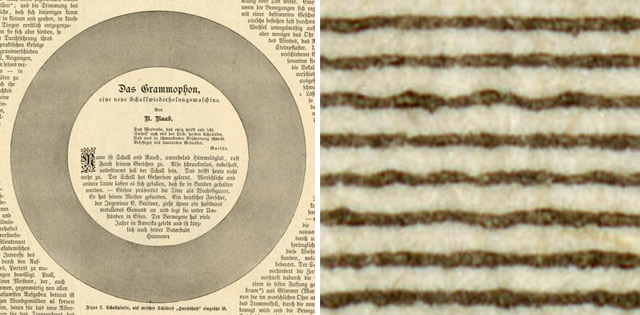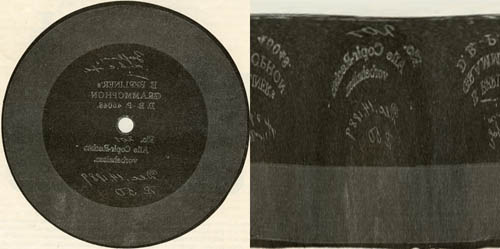Extract audio from record photos

Imprint of a gramophone record in a German magazine (February 1890) and an enlarged fragment of the scanned image
The invention of the gramophone dates back to 1887, the first records appeared on sale in Europe in the summer of 1890. The museums of the world hold several experimental gramophone records of 1887–1888, which are considered to be the oldest records in the world. Unfortunately, counting the sound from them is almost unreal. Worse, almost all the old records are preserved only in the form of photographs. That is why in the modern digital archives the oldest audio recording dates back only to 1893 . But experts from Indiana University have found a way to restore the sound from the record on one photo.
The process begins with a high resolution scan. Scan is cut into fragments to turn the circle on the plane.

')
Each fragment of the spiral audio track is cut and joined to the next. The joints are neatly processed, so that the entire helix from the plate is converted into a direct audio track.

The white line in the screenshot above is a sound wave. To restore its original form as accurately as possible, you need to take the black areas above and below the sound wave - and send it for processing to the ImageToSound program. At the output we get a wav file.

The illustration shows the original sound wave from the scan (above), a pair of black areas above and below it (in the middle) and the result of the ImageToSound (below).
Specialists from Indiana University were able to restore several audio recordings in this way. For example, one of them is the record of November 11, 1889, made in Hannover. It contains a speech in German, where the inventor of the gramophone Emil Berliner demonstrates the process of recording a non-resident citizen named Louis Rosenthal, who is about to take the device home for experiments with sound recording. Until now it was thought that this is the oldest gramophone record, you can listen to it here .
The imprint at the very beginning of the article is a previously unknown audio recording, which met as an illustration of an article about a gramophone in the German magazine Über Land und Meer for February 1890.

The journalist in the article tells how to make a copy of the audio disc and that to play the sound you need to scroll it at 50 revolutions per minute, and you can make a sound with a bamboo stick 15 cm long and ¾ cm thick, to one end of which you need to attach a sewing needle 1 cm , at an angle, and gently press it against the surface of the rotating disk. After that, you can hear the words that are recorded on the sound plate, especially if you put cotton plugs in your ears. It was written in the article that Schiller's poem “Glove” was recorded on a record.
At Indiana University, they managed to restore this audio recording. According to experts, this is another entry that Berliner personally made (at that time no one except the inventor had any gramophones).
You can listen to it here, mp3 ( transcription , translation into Russian ).
This record was probably given by Berliner to Rosenthal as a sample, along with a gramophone. Thus, the recording was made before November 11, 1889 and is de facto the oldest gramophone record in the world.
Source: https://habr.com/ru/post/175695/
All Articles